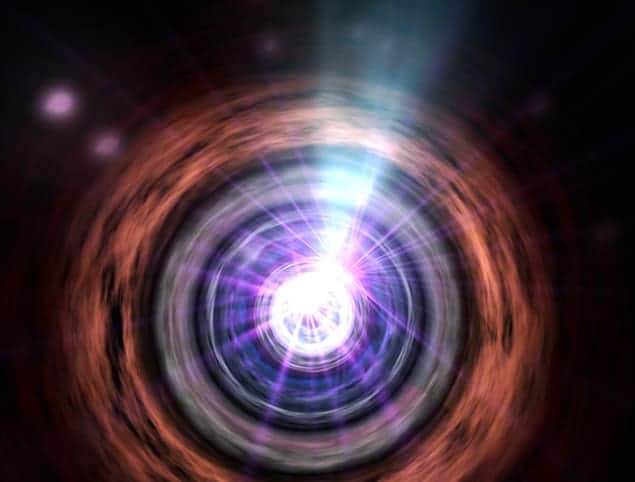
An international group of researchers has developed a new way to measure accurately the extragalactic background light (EBL) that fills the universe. The technique involves measuring the attenuation of high-energy gamma rays from distant blazars and it could improve our understanding of how galaxies form and evolve, as well as how the universe has expanded since the Big Bang.
The EBL is made up of all the ultraviolet, optical and infrared photons ever emitted by all galaxies in the universe and, like the cosmic microwave background, is expected to contain a wealth of information about how the universe has evolved. However, measuring the totality of all of the light in the universe is no mean feat. One major problem is that the solar system itself nestles within the Milky Way – a bright galaxy – making it difficult to distinguish between the local galactic light and the much fainter background light. Indeed, most current ground-based and space telescopes have failed to do so reliably enough, while sending a spacecraft out of the galaxy to detect the EBL is clearly impossible.
Across the universe
Instead, astronomers use other, more indirect, methods to detect the EBL. One of these involves using galaxy surveys to estimate the total number of photons produced from the observed population. Once more, the issue here is that the surveys could easily be missing the faintest of galaxies; if these are large in number, they might contribute a lot of light to the EBL, so not factoring in these and any other potential sources would mean that the results are incorrect.
The second method involves blazars. These are compact quasars – supermassive black holes that sit at the heart of active galaxies – with relativistic jets of plasma pointing in the general direction of the Earth. These jets produce extremely energetic gamma rays. According to Alberto Domínguez, a postdoctoral researcher at the University of California, Riverside and lead researcher of the new study, these gamma rays are attenuated as they travel, colliding with EBL photons en route. “There is an effect called pair-production, where two photons that satisfy certain energy conditions interact to produce an electron and a positron. This interaction happens between gamma-ray and EBL photons, producing an attenuation in the gamma-ray flux that we observe from blazars,” says Domínguez. “If we could somehow figure out the intrinsic gamma-ray flux, then we could compare it with the observed flux,” he explains, saying that the comparison could give an estimate of the EBL.
But the team faced some challenges with the new method, the main one being how to figure out the intrinsic gamma-ray flux, which is not known initially. Domínguez says that other groups have tried to estimate this flux by using rather simplistic assumptions. “We have a more elaborated technique that uses data taken from X-ray satellites [NASA’s X-ray satellites Swift and the Rossi X-ray Timing Explorer] and the Fermi Space Telescope, which detect photons at lower energies that are not EBL attenuated,” explains Domínguez.
Then, using standard models of blazar photon emission from observations of nearby blazars, the team inferred the expected intrinsic gamma-ray flux at higher energies and compared it with actual observations from Cerenkov telescopes on the ground. “A comparison between the predicted un-attenuated gamma-ray brightness at energies greater than 30 GeV and the detected attenuated brightness at energies greater than 30 GeV by the Cerenkov telescopes allows us to estimate the cosmic gamma-ray horizon that is directly related to EBL attenuation,” says Justin Finke of the US Naval Research Laboratory, Washington DC, who is also a member of the team.
More distant blazars
By applying their technique to blazars located at different distances (or different ages of the universe), Domínguez and colleagues measured the EBL out to five billion light-years away – the location of the most distant blazar observed when the team began its study. According to the researchers, they can now study more distant blazars that are being detected with the current generation of Cerenkov telescopes, as well as those that will be detected in the future with the next generation of Cerenkov telescopes, namely the Cherenkov Telescope Array.
Domínguez has used both of the methods discussed to measure the EBL and he points out that, interestingly, both give similar results. This helped in setting essential limits on the light from faint galaxies missed in current galaxies surveys and also on any other potential contribution to the EBL not coming from galaxies. “What this means is that the sort of galaxies that we are observing now, with our surveys, are actually responsible for most of the EBL,” he says. The researchers also plan to extend their work to more blazars both at the same distances that they have already tested to confirm their results and also those further away.
Because the EBL is intrinsically linked to the star-formation history of the universe, efficiently measuring it is essential. Other research from Domínguez that looks into measuring the expansion rate of the universe from the attenuation will be published in the months to come.
The research is published on the arXiv preprint server.



